We live in a data-driven economy. At any moment, vitally important information is being shared across the globe.
That includes heavily encrypted communique between world leaders. Or maybe it’s just a grandma sharing photos of her grandkids on Facebook.
No matter why data is being shared, and no matter who is sharing it, data is shared on networks, and tending to each and every one of those networks is an information technology professional.
In this guide, we’ll tell you the degrees you need to get started in this exciting industry, including just a few of the great careers made possible, every step of the way.
You’ve heard of information technology. It’s now time to find out if a future in the field is the right choice for you.
See Also: How Hard is it to Get a Job in Computer Science?
What Is Information Technology?

From the highest levels of government and corporate board rooms to the doctor’s office up the street, computer networks are everywhere. Across those networks, countless emails, as well as other vitally important documents and other forms of data, are transmitted daily. That communication must remain reliable and secure at all times.
Information technology, sometimes called information science, studies the form that data takes as it moves across those networks, as well as a bit about how those networks are constructed.
How can data move most efficiently and securely? What are new and innovative ways to share information, assuring both privacy and reliability? Answering those questions is the job of an information technology professional.
There’s an important distinction here to be made between information technology and information systems. Those who study information systems study the network itself, while information technology is about the actual information, data, and files: what form it takes, how it travels, and how safe that data remains along the way.
Best of all, IT degrees help you think critically, a skill that is applicable in a broad range of careers beyond just computer science, according to David Johnson. Johnson graduated in 2003 with a degree in computer science from the University of Missouri and is now chief technology officer at Mulytic Labs and founder of Clear Blue Data.
“Technology is everywhere, and being able to use it comfortably is becoming a cornerstone to success in any industry,” Johnson tells Online Schools Report. “IT is now becoming a fundamental skill for almost any career path,” he says.
In their work, IT professionals known as architects develop computerized networks and databases. That’s while other IT professionals administer those networks and databases. With the sharp increase in computer systems at every level of industry and private life, the number of available IT positions have skyrocketed.
So too have degree opportunities proliferated from institutions large and small for those looking to get into this lucrative and rewarding field — from ivy-covered college campuses to quality online schools.
A Bachelor of Science (BS) in Information Technology is perhaps the most common degree type in this major. As previously mentioned, information science and technology are also well-suited for the format of an online degree. In turn, many choose that route to complete their education.
Also notable is that information technology is one of the rare industries where many good-paying career opportunities are afforded by an associate degree. Nevertheless, Master of Science (MS) in Information Technology and even doctoral-level degrees, both PhDs and doctorates, exist in this field of study, all with their own list of career opportunities.
In this article, we’ll tell you more about just a few of the many exciting careers made possible by a degree in information technology. We’ll also tell you what you need to know about each degree offering in this versatile and rewarding field.
Careers in Information Technology
A graduate with a degree in information technology will be well-prepared for the workplace of the future. Listed below are just some of the many career paths opened up by an IT degree.
| Job Title | Approx. # years of education | Average Annual Salary |
| Computer Network Architect | 4 | $112,690 |
| Network and Computer Systems Administrators | 4 | $83,510 |
| Computer Support Specialist | 2 | $54,760 |
| Information Security Analyst | 4 | $99,730 |
| Software and Application Developer | 4 | $107,510 |
All salary data is courtesy U.S. Bureau of Labor Statistics Occupational Outlook Handbook.
Computer Network Architects

Digital information travels along networks. Above all else, these networks must be efficient and secure, ensuring a safe and swift journey. Building and maintaining those networks is the job of a computer network architect, and an information technology degree is a great first step on this career path.
There are many different kinds of computer networks: local area networks (LANs), wide area networks (WANs), and intranets. Many computer network architects specialize in one specific kind of network, while others gain proficiency in all three.
Rather than maintaining and updating a pre-existing network, network architects sometimes play a crucial role in creating and implementing plans for new data networks, building them from the ground up.
To make sure architects are providing the best of what’s available, they must also research the marketplace to stay on top of the rapidly changing world of technology.
Network architects must also stay abreast of developments in security technology, a vital part of any functioning network, and those plans must pass the approval of clients and management.
Other responsibilities include updating newtork hardware, such as switches and routers, as well as network software.
According to the Bureau of Labor Statistics, computer network architects make about $113,000 a year on average. There are 160,000 positions across the U.S. That number is expected to grow at a rate of 5% in the decade 2019 – 2029, on par with many other professions.
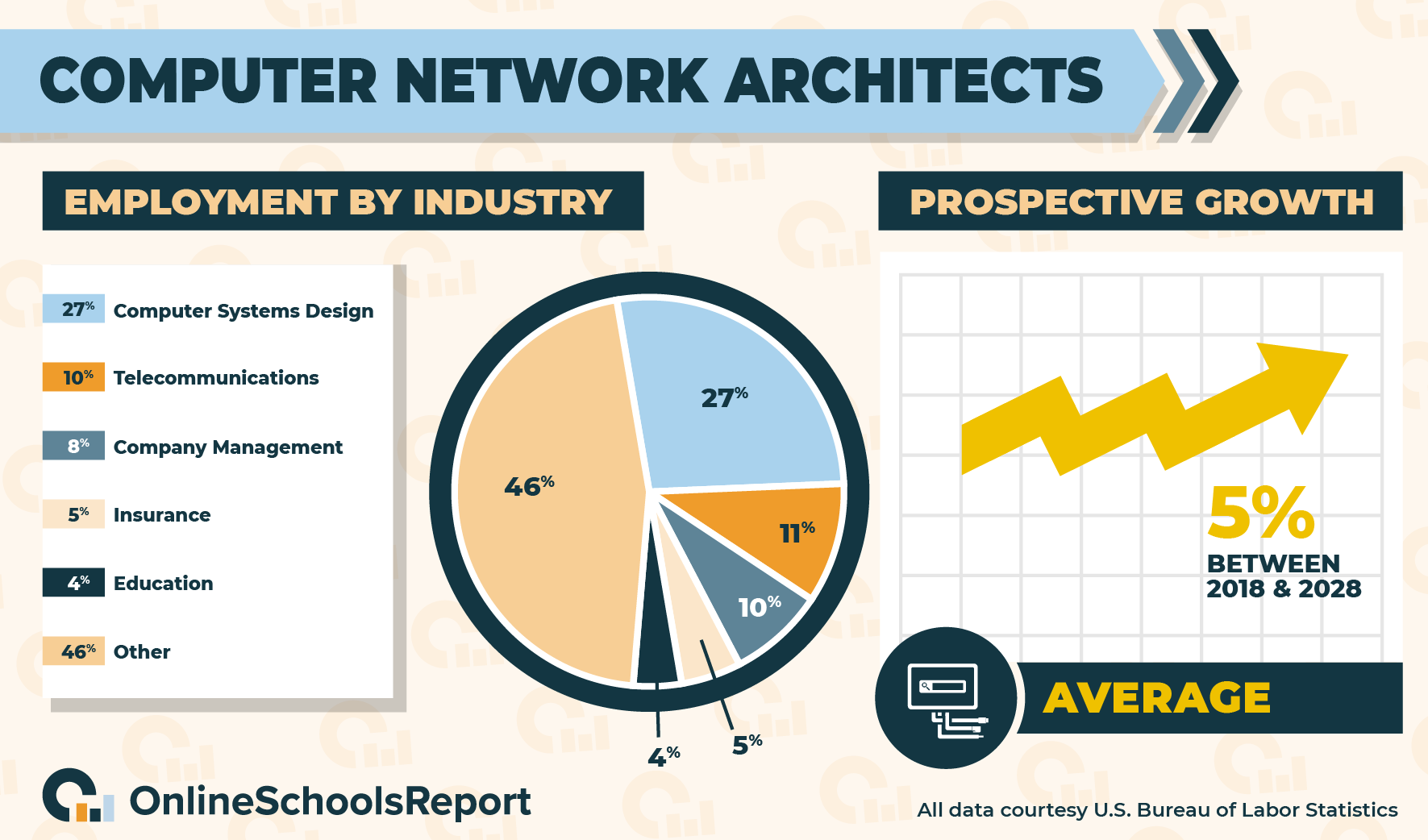
BLS data also states that a bachelor’s degree, most often in a computer science-related field like information technology, is the minimum educational requirement to work as a computer network architect. Couple that with at least five years of experience in an entry-level computer networking position, such as a network and computer systems administrator, and you should be a solid fit for most companies.
That said, some employers do prefer a Master of Business Administration (MBA) in Information Systems.
On top of a degree, professional IT certifications do exist and can help improve job opportunities, though they aren’t commonly required as a condition of employment. One such credential is CCENT, or Cisco Certified Entry Networking Technician, among many others.
Also according to the BLS, 27% of computer network architects work in computer systems design and related services while 10% work in the telecommunications industry. Following that, 10% work in the telecommunications industry, and 8% work in company management. An additional 5% find work in the insurance industry and the remaining 4% work in education.
Good states to live for computer network architects include California and Texas.
Network and Computer Systems Administrators

Once a computer system or network is built, who installs and maintains it? That’s the job of a network and computer systems administrator.
Holding degrees in information technology, administrators of this sort strive to ensure the reliable day-to-day operation of these networks. That includes the organization and support of LANs, WANs, network segments, intranets, and other kinds of data communication systems. Clients include a wide variety of businesses and organizations in the public and private sector.
In this work, network and computer systems administrators work closely with an organization. They must determine the needs of the organization before developing and installing appropriate hardware and software. Administrators are also charged with making the needed upgrades and repairs to the network over time while always keeping a keen eye on network security.
Other responsibilities include evaluating and optimizing the network for peak performance while adding and training new users. This training can include updating network security permissions. And if any problems should arise, the administrator must swiftly address the issue when alerted, either by a user or through an automated monitoring system.
According to the Bureau of Labor Statistics, a bachelor’s degree in a computer science-related major is the minimum educational requirement to become a network and computer systems administrator.
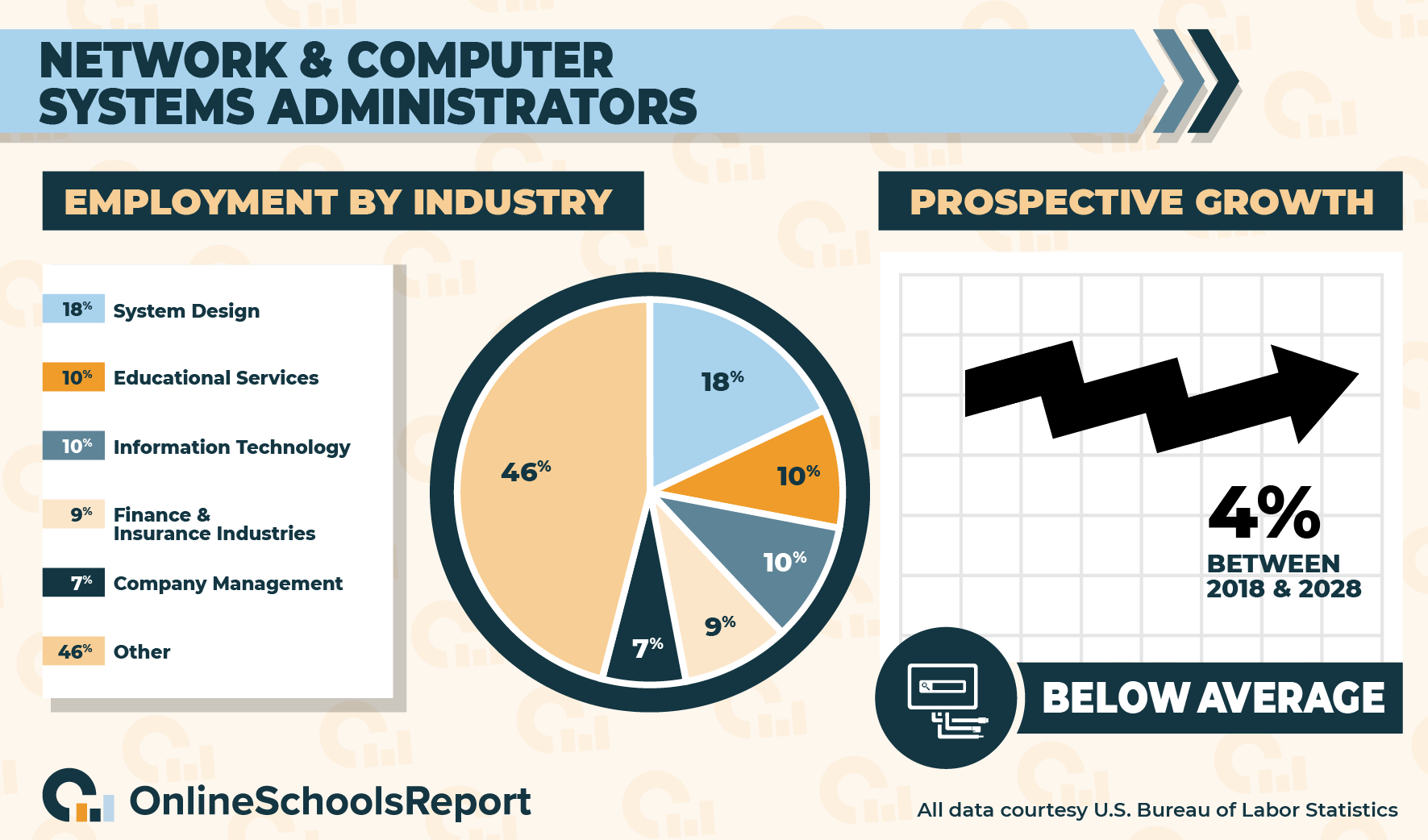
Certifications and credentials are rarely required, though they do exist and can help improve employment opportunities, such as the CompTIA Network+ certification.
Data from the BLS also states that network and computer systems administrators make about $84,000 a year, and there are about 374,000 jobs in the U.S. alone. That mark is expected to grow by 4% in the years spanning 2019 – 2029, which is about average for most professions, reflecting good job security in the industry.
Also according to the BLS, 18% of network and computer systems administrators work in system design and related services. Following that, 10% work in educational services, while an additional 10% work in the information technology industry. The BLS goes on to state that 9% work in the finance and insurance industries, and 7% work in company management.
Good states to live in for network and computer systems administrators include Texas and California.
Computer Support Specialists

Computer networking and information technology industries are examples of industries where good-paying jobs can still be found with relatively little education. Working as a computer support specialist is one such career.
While holding a BS in Information Technology certainly doesn’t hurt the chances of finding work in this profession, many employers simply require an associate degree or even just demonstrable knowledge, regardless if those skills were self-taught.
In addition to providing user support and technical assistance, computer support specialists test and evaluate existing systems. That includes performing regular maintenance, sometimes daily, as well as troubleshooting possible issues. These tasks are sometimes performed in-person as well as through email or even over the phone.
Networks under the purview of a support specialist, sometimes called a technical support specialist or a help-desk technician, include both LANs, WANs, and internet systems. Support specialists may perform duties like backing up files on the network. And in the event of a network-related disaster, the support specialist will be among the first to help address the issue.
As previously stated, computer support specialist positions are among the few well-paying jobs that can be obtained with very little formal education, sometimes just a high school diploma with relevant experience, or an associate degree in a computer science-related major like information technology. Specific network certifications can also help improve employment opportunities.
According to the Bureau of Labor Statistics, computer support specialists make about $55,000 a year on average, and there are 882,000 support specialist positions throughout the U.S. That number is estimated by the BLS to grow at a rate of about 8% in the decade between 2019 – 2029, which is faster than average.
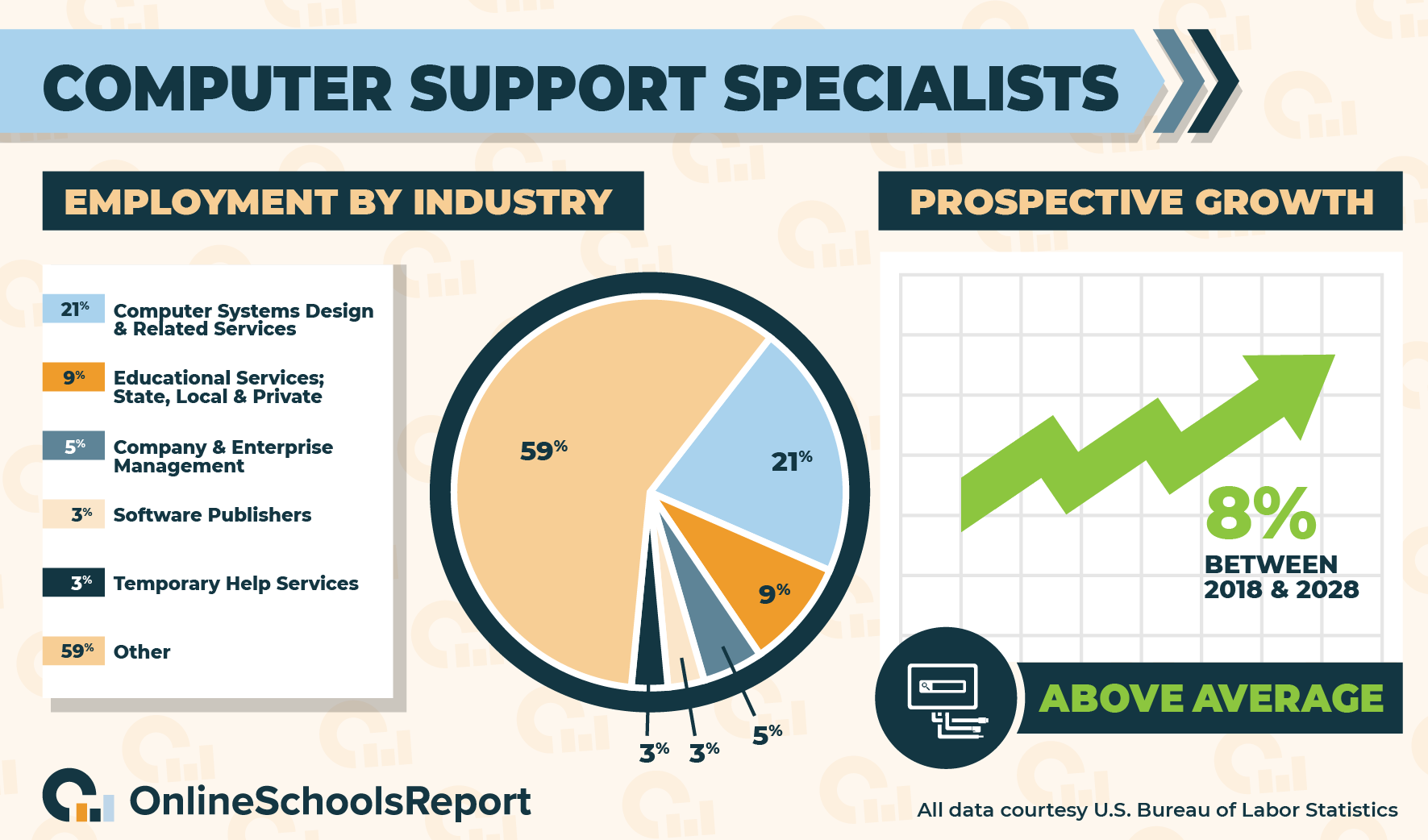
The BLS breaks employment data in this profession down into two related subcategories: computer network support specialists and computer user support specialists. As far as computer network specialists, the BLS states that 19% work in computer systems design and 11% work in telecommunications. Following that, 7% work in the financial and insurance industries and 6% work in company management. The final 4% work in data processing.
Turning to computer user support specialists, 22% work in computer systems design and 12% work in education. An additional 5% work in company management and 4% are employed by software publishers. Following that, the final 4% work in temporary support services.
Good states to live in for both of these professions include California and Texas.
Information Security Analyst

Information security analysts are IT professionals charged primarily with ensuring, updating, and evaluating the security of a computer network. It’s a natural fit for anyone with an educational background in information technology.
In their work, information security analyst’s primary concern is to protect an organization’s network. That includes monitoring, investigating, and documenting security breaches, including the extent of the damage if an attack should occur under their watch.
Security analysts also protect important information through the installation of data encryption software, firewalls, and through simulating attacks through network penetration testing. Security analysts must also stay on top of the latest trends in IT security, both software and hardware related, while developing, documenting, and implementing network security best practices.
Analysts may also provide some user support related to network security while advising IT management and senior staff on matters related to network security.
A bachelor’s degree with about five years of work experience is the minimum qualification to become an information security analyst, according to the Bureau of Labor Statistics. Some IT degrees allow concentrations in network security.
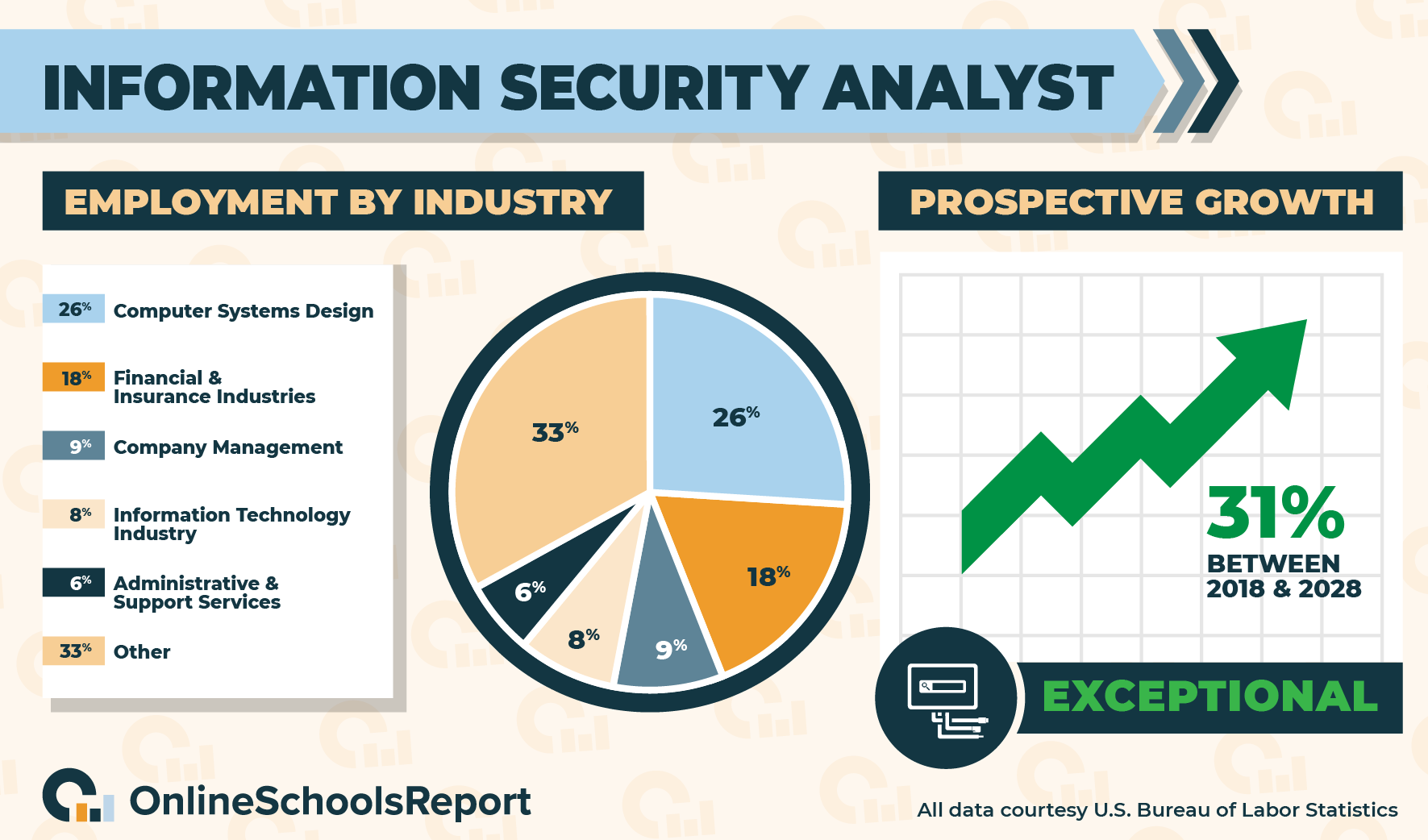
An additional professional credential to improve employment opportunities for information security analysts is the Certified Information Systems Security Professional (CISSP) certification.
BLS data also states that information security analysts make about $100,000 dollars a year, and there are roughly 131,000 positions in the U.S. That total is expected to grow at an astounding 31% in the decade spanning 2019 – 2029, which is just about six times the rate of growth in other professions. This means that if job security is a priority, then information security is the right choice for you.
Also according to BLS data, 26% of information security analysts design computer systems and 18% work in the financial and insurance industries.
Following that, an additional 9% work in company management, and 8% are employed in the information technology industry. The final 6% work in administrative and support services.
BLS data also states that if you live in Virginia or Texas, you have a good chance of finding work as an information security analyst.
Software and Application Developers

Working as a software and application developer is also a common career choice for information technology majors. In this role, IT graduates develop and create systems and applications to run on computers and other devices.
That could be a piece of software created to perform a specific task or an application related to the underlying functioning of the system of the network. Many software developers specialize in one or the other, while others are proficient in both.
The first step of any software or application development process is to evaluate the needs of the end-user. Working in close collaboration with other computer specialists, software developers may also recommend specific pieces of software or software upgrades to satisfy those, but sometimes a new application is the only solution.
That software design process can initially take many forms, such as diagrams and flowcharts. Programmers then use this information for coding. After the software is complete, the next step is to ensure it runs properly. That involves regular maintenance and testing, which must also be carefully documented.
According to the Bureau of Labor Statistics, software and application developers make about $108,000 dollars a year on average. There are also about 1.5 million jobs for software developers in the U.S. and that already impressive number is predicted to grow at a rate of 22% from 2019 – 2029. That’s well above the average rate of growth in many other lines of work.
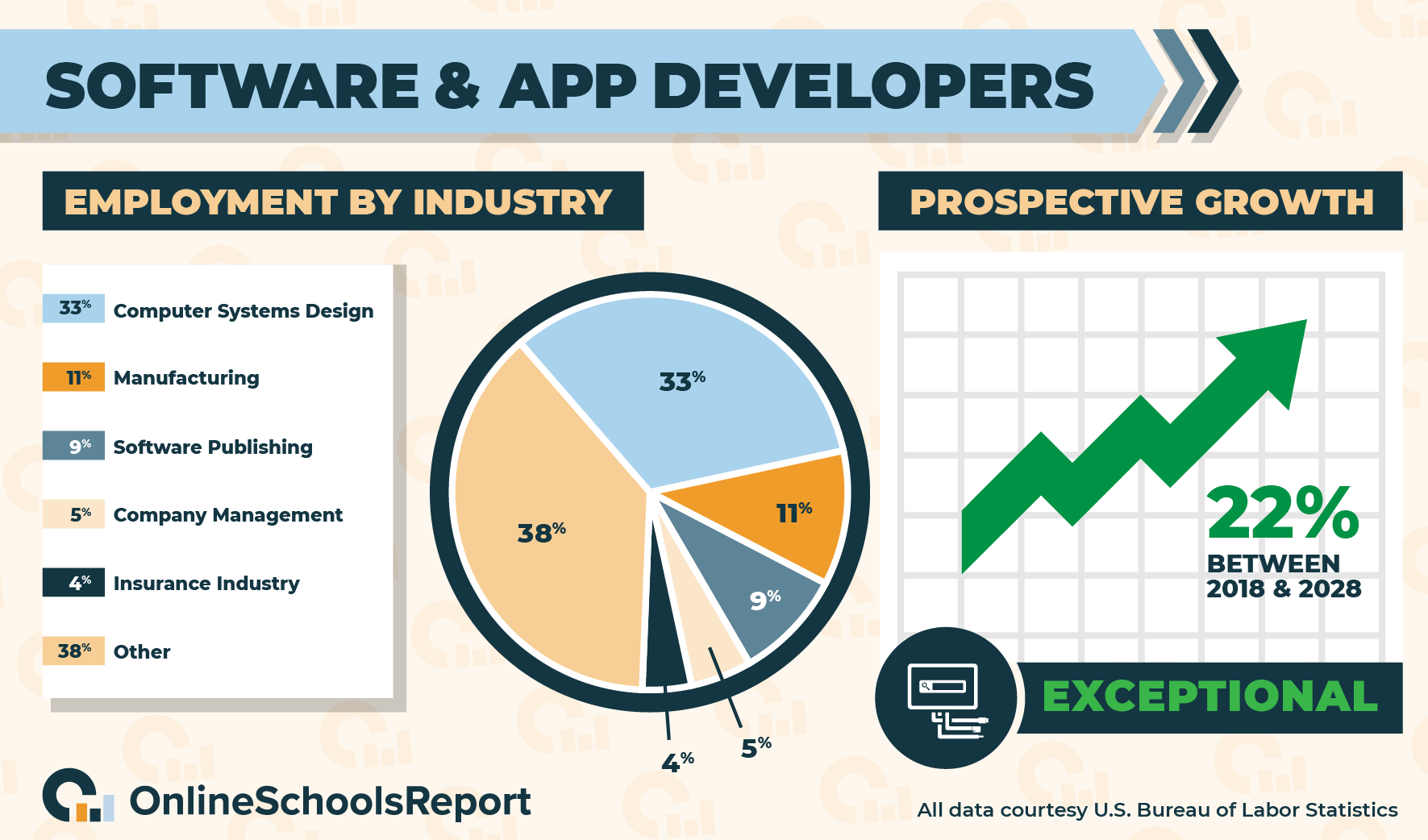
BLS data also states that a bachelor’s degree in a computer science-related major like information technology is typically the minimum educational requirement to become a software and application developer. Specific coding language certification can also be helpful in securing a job, such as the Oracle Certified Associate (OCA): Java SE Programmer credential.
Also according to the Bureau of Labor Statistics, 33% of software and application developers work in computer systems design. Following that, 11% work in manufacturing and 9% work in software publishing. An additional 5% work in company management and the final 4% work in the insurance industry.
States with high levels of employment in this profession are California and Texas.
Information Technology Degrees
Ready to get your start in any of the careers mentioned above? It all starts with a degree in information technology. In our next section, we’ll tell you what you need to know about any one of the many great degree offerings in this exciting subject.
Associate Degree in Information Technology

One advantage of choosing to major in information technology is that a variety of lucrative careers can be found with just an associate degree. Associate degrees in information technology are offered both as an Associate of Science (AS) or an Associate of Applied Science (AAS).
Both degree options lay a strong foundation for a long and lucrative career in information technology. The primary difference between the two rests in what a student intends to do after graduation. An AAS degree is a highly vocational degree path that prepares a student for an entry-level position in the IT industry.
While it is possible to enjoy employment opportunities in IT with an AAS degree, career advancement opportunities may be limited.
An AS degree, on the other hand, will provide many vocational skills with a grounding in general education, preparing a student to transfer their credits to a four-year college or university to complete a bachelor’s degree.
Given the technical nature of the subject matter, many associate degrees in information technology are offered completely online or in a hybrid model, while still others are offered in the traditional classroom environment. Both AS and AAS degrees are offered at public and private trade schools,as well as local community and junior colleges.
Concentrations offered by many associate degree programs in IT include eCommerce, multimedia, and even bioengineering, the nexus of medicine and technology. In addition to general education, common coursework covers topics such as an introduction to networking, human-computer interaction, and web design and development.
A high school diploma or equivalent with transcripts is the prerequisite for any associate degree program, with a GPA of at least 2.0, but admission requirements may vary. SAT scores may also be required. Associate degree programs typically consist of about 60 credits, which takes most students about two years to complete, though this too can vary.
Bachelor’s Degree in Information Technology

Commonly abbreviated as BSIT, or a B.Sc IT, a Bachelor of Science (BS) Degree is the next degree offered in information technology. One variation on the degree offered by some schools is a Bachelor of Science in IT Management.
Regardless of what the degree is called, the outcomes will be similar. Building on the groundwork laid down by an associate degree, a BSIT will move further away from the vocational into the theoretical, preparing graduates to work in positions of management as well as research and development.
As well as general education courses, coursework in a Bachelor of Science in Information Technology program will cover topics like database management, network administration, programming, and information security, to name only a few.
Additional skills learned through the degree may include principles of organizational management, preparing students for management and leadership roles in the IT industry, as well as ethics related to information, data, and communication.
Like an associate degree, BSIT and variations thereof are offered online only, in a hybrid model, or in the traditional in-person format.
A high school diploma or equivalent or an AS degree with transcripts is the minimum prerequisite for a BS program in IT. SAT scores may also be required. The AS may not need to be in IT specifically but simply in a computer science-related topic, but admission requirements can vary.
A bachelor’s degree typically takes 120 credits to complete, which takes most students about four years, though this can depend on a lot of factors. Some cut time and save money on their bachelor’s degree by completing a portion of their credits through an AS degree. BS degrees are offered at both public and private trade schools, as well as public and private colleges and universities.
Master’s Degree in Information Technology

A Master of Science (MS) Degree in Information Technology is the next step on the educational path of an IT professional. And just like how a Bachelor of Science moved from the vocational to a more theoretical and research approach to the subject matter, a Master of Science in Information Technology will do the same.
Part of many master’s degree programs is a terminal thesis, though they are less common in MS programs generally speaking. Nevertheless, this thesis will be developed in conjunction with a faculty advisor and might be a condition of graduation.
So too is extensive fieldwork, practicums, and internships that provide invaluable professional experience at the upper levels of the IT industry.
The curriculum in an MS in Information Technology will cover subject matter like data science and data warehousing, the Internet of Things (IoT), and cloud computing, among many other relevant topics.
Careers made possible by an MS in IT include chief information officer for a broad range of organizations, chief technology officer (CTO), or a computer systems analyst, among others. Many who earn an MS in IT also teach at the college or university level.
The curriculum will cover subjects like cloud computing, data warehousing, and project management. A bachelor’s degree with transcripts in a computer science-related major like information technology is a prerequisite for an IT master’s program. Letters of recommendation and a statement of personal intent may also be required.
A computer science-related bachelor’s degree may not be required, depending on the program, so long as certain prerequisites are satisfied.
A GPA of 3.0 is also often the minimum GPA mark for a master’s-level student in IT. GRE scores may also be a requirement, though admission requirements can vary. Versatility is also a trait in MS programs in IT, with many offered virtually, while others are hybrid, and still more are in the traditional campus environment.
Total credit hours required to complete the degree vary between programs, as does the average time most students take to graduate. Many graduate programs, however, consist of 40 credit hours, which many students can complete in about two years of classwork, though many master’s-level IT programs are designed to work around the schedule of working professionals.
Doctorate Degree in Information Technology

For those interested in continuing their education beyond the level of a master’s degree, there are a variety of doctoral-level degree programs in information technology. These are offered as both doctorates, such as a Doctor of Information Technology (DIT), or as PhDs, such as a Ph.D. in Information Systems.
The primary difference between the two is the thesis requirement of a Ph.D. program, as opposed to the more practical and hands-on focus of a doctorate degree, emphasizing practicums and fieldwork with professional outcomes.
For these reasons, students interested in working at the highest levels of management in the IT industry often choose a doctorate degree while Ph.D. candidates might be best suited for research and teaching.
Otherwise, areas of emphasis in any doctoral-level degree in information science will cover topics and areas of emphasis like general information technology, project management, information assurance, and cybersecurity.
A master’s degree in a computer science-related major like information technology is a minimum prerequisite for a program of this sort. Transcripts, GRE scores, and a GPA of at least 3.0 may also be required, though this can vary between programs. Letters of recommendation or statements of personal intent are also common in application packages.
Another key difference between Ph.D. and doctorate programs are the total credit hours required to graduate. Ph.D. programs often ask for 120 hours of coursework, completed online, in-class, or in a combination of workshops and seminars. Doctorate programs sometimes ask for less coursework, only about 58 credits hours, that are also able to be completed in a variety of ways, including online, in-person, and in a hybrid format.
Many students complete these programs in less than two years, though still others take much longer to develop, write, and defend their thesis. Many students also teach at the institution from which they’re earning their degree, and most programs are designed to accommodate the schedule of a working professional.





